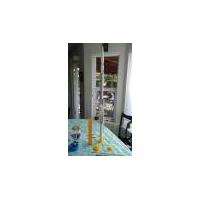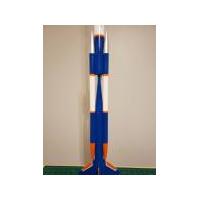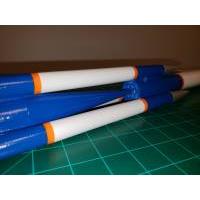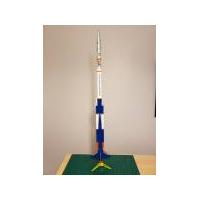| Construction Rating: | starstarstarstar_borderstar_border |
| Flight Rating: | starstarstarstarstar_border |
| Overall Rating: | starstarstarstarstar_border |
| Published: | 2020-05-28 |
| Diameter: | 1.33 inches |
| Length: | 42.20 inches |
| Manufacturer: | Estes  |
| Skill Level: | 4 |
| Style: | Futuristic/Exotic |
 Brief
Brief
The Astron Explorer is a high-performance sport rocket that looks like a futuristic space vehicle. It is a fun, but challenging Level 4 "Master" kit to build and finish.
The final result for the careful and patient craftsman will be an eye-catching, high-flying D and E motor powered rocket.
DISPLAY TIP:
This rocket cannot stand up on its fins. Use of a stable display stand designed to hold a tall, D and E powered rocket is recommended.
Components
One of Estes larger rocket kits, it includes an 11" long plastic nose cone that resembles a futuristic spaceship command and service module; five body tubes (two main and three auxiliary); 3/16" laser-cut balsa fins; seven plastic detail cones and a plastic tail cone; a heavy-duty extra-long rubber shock cord; a large assortment of waterslide decals, and an 18" diameter plastic parachute.
A unique feature of this kit is its ejection gas transfer system. The three auxiliary body tubes are designed to transfer ejection gases from the lower body tube which houses the motor to the upper body tube which houses the recovery system. This reduces, but does not completely eliminate, the need for recovery wadding.


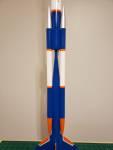

Construction
Kit instructions are generally complete and not hard to follow. That said, this is not a Beginner's kit.
Body tube marking, cutting, and alignment are critical to the successful build of this model. Patience is required at several points in the assembly process.
Accurate and readily visible body tube markings are critical to make using the supplied paper guides.
Skilled use of a sharp Hobby Knife is required to accurately cut 12 narrow slots in the five body tubes; three in each main tube and two in each auxiliary tube. These slots when properly aligned and glued serve as channels for the ejection gases. TIP: If possible, a builder should practice cutting narrow slots in a scrap body tube before attempting to cut the kit's tubes.
CAUTION: Cutting the slots too long or wide risks ruining the model. Cutting them too short or narrow and the ejection gases may not adequately transfer to the upper body tube which could result in failure to deploy the parachute.
Mounting and gluing the functional and decorative card stock into the upper and lower body tubes requires careful part fitting.
Final rocket body assembly requires the use of alignment jig templates that are included with the kit. The alignment jigs are simply to prepare and work well.
A flat surface at least 36" wide by 12" deep is needed to assemble, align, and glue the rocket body assembly.
TIP: Prior to gluing this assembly, I recommend that the builder practice aligning the six ejection gas slots as held in place by the jig templates. Once things appear aligned, shine a bright flashlight beam into the open end of each main body tube. If you cannot see light when looking into each opening of the auxiliary body tubes, then the ejection gas slot(s) may need further careful cutting out or better alignment. While hard to fully describe here, in practice the value using a flashlight beam to double-check that ejection gas slots are adequately shaped and aligned will become obvious. Remember to adjust the body tube markings if needed prior to gluing.
The rocket body assembly should not be moved and the jig templates should remain in place until everything is completely dry.
Adding glue fillets everywhere indicated is vital to ensuring a robust rocket and a completely sealed ejection gas transfer system.
TIP: Apply glue fillets at least twice to each joint. Let the glue dry between fillet applications.
Ensure all glue joints and fillets are completely dry before proceeding to the next step in the build.
Finishing
PROS:
None I could identify.
CONS:
The instructions for finishing this model are the weakest aspect of the entire kit. They lack adequate illustrations and tips for ensuring precise painting and application of the decals, and there are no alternate paint schemes suggestions which can make a very big difference in the rocket's finished appearance.
The kit comes with over 20 black and orange waterslide decals that are applied to the nose cone, body tubes, and fins. When carefully and precisely applied they look great and bring out the model's futuristic appear; however, some decals are very small and all of them are typically quite fragile. There are no spare decals in the event one or more of them are ruined while attempting to apply them. This is typical for an Estes kit.
TIPS:
Paint the nose cone with metallic silver paint. It brings out considerable detail in the futuristic nose cone and when decals are applied it imparts a high degree of realism to the rocket.
Paint the six small detail cones and the tail cone with contrasting colors, such as silver, black or orange prior to attaching them to the model.
Apply a protective clear coat to the entire model after the decals have thoroughly dried; making sure to use the same sheen (e.g. semi-gloss) that you used for the body paint.
Flight
The Astron Explorer flies very well when properly assembled and launched using a 3/16" diameter launch rod that's at least 35" long.
The recommended D12-3 motor is a good choice for use in medium-size open fields on days with light to no wind. You get a solid boost.
The recommended E12-4 motor is a great choice for use in large to very large open fields with good spotting support on days with light to no wind. You get an excellent boost that puts the Explorer out-of-sight in a nearly straight up launch.
CAUTION: Use of motors with longer delays is not recommended by Estes. With a D12-5 or E12-6 the rocket may gain too much descent speed, risking unwanted parachute and body tube damage when the ejection charge fires.
Recovery
PROS:
Use of the supplied 18" parachute results in a slow descent which is great for avoiding fin or other damage upon landing. You also enjoy relatively long duration flights.
Note: Using an E12-4 motor I have recorded flight times from launch to touchdown of over 2-minutes 30-seconds on hot days when the parachute catches an updraft or two.
CONS:
Use of the 18" parachute will result in long-distance drifting on windy days that could result in loss of the rocket.
TIP:
Cutting a 3" diameter Spill Hole may reduce drift by modestly increasing descent speed.
CAUTION:
Use of a smaller diameter parachute could further reduce drift, but it increases the risk of a hard landing that could damage one or more of the large balsa fins located at the base of the rocket.
Summary
Although challenging to build and finish, this kit will provide the experienced rocket builder with a very satisfying end product that he or she will be proud to display and fly!
 |
 |
Flights
 |
 |
